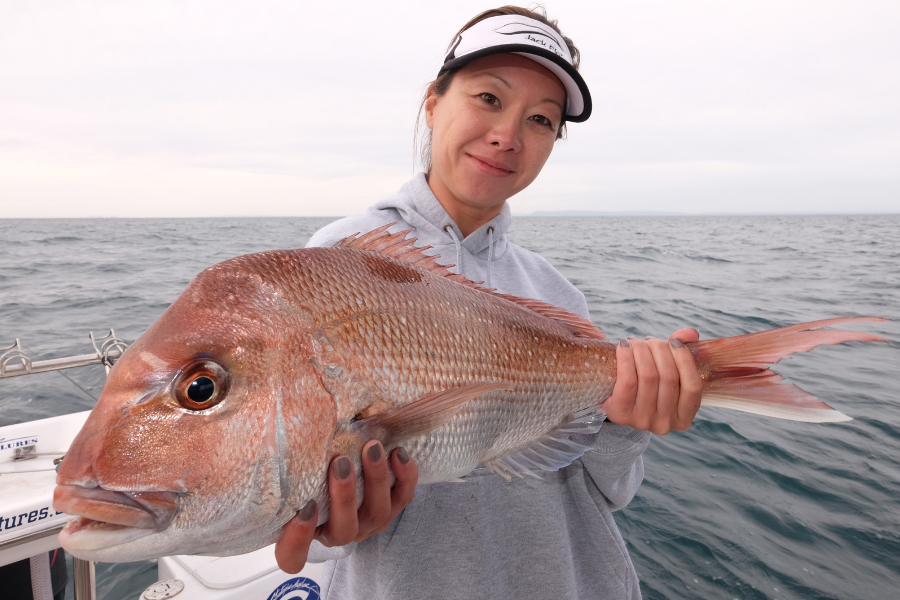How to catch snapper
Boat fishing
Snapper can be caught in a variety of ways in Port Phillip. Bait fishing at anchor is most popular although lure fishing is also effective. Bay snapper are found in several places including reef at places like Ricketts Point or smaller patches of reef that are scattered throughout the bay. Snapper also school over mud or shellfish beds off Seaford and Clifton Springs. Most of the time, snapper swim in the lower part of the water column. Bait fishers sometimes drift or anchor their boats where snapper have been observed on a fish finder. Having anchored, bait rods are rigged with a single or double snelled setup, depending on bait type and size, with a running sinker to suit the depth and conditions. Baits include pilchard, silver whiting, squid or other fish in whole or cut form. Lines are cast out in a fan shape from the rear of the boat and secured in a sturdy rod holder. The next step is berley to attract the fish to the boat or keep observed fish nearby. Patience if often rewarded and moving around too much is unwise. Snapper feeding patterns will usually see a rod buckle and a fish on! Lure fishers can use soft plastics, slow pitch jigs or weighted vibes. Lure fishing can be at anchor, though results can improve by drifting over productive ground and returning when you have drifted away. An electric motor is a great advantage to control a drift or stay in a position without deploying an anchor to the bottom. Drifting and casting ahead of the boat is a fishing style popular with kayak fishers paddling in shallow waters close to the shore.
Bait fishers
Bait fishers will be well served by a 6.5-7.2ft composite rod of 4-7kg rating, a 3000-5000 sized reel and 15lb monofilament line. A short monofilament leader of 40lb, single or twin 5/0 circle hooks and a running sinker to suit the conditions are recommended. Just ensure your bait reaches the bottom!
Lure fishers
Lure fishers will be better served with a 7ft composite rod of 2-5kg or 3-6kg rating with a spin reel no larger than 3000 size. 10-12lb braided line and a rod length of leader of 20lb monofilament or fluorocarbon is a great outfit. Use a paddle tail grub or flick bait style soft plastic of 3-4“ with a jig head to suit the depth you are fishing. The ideal scenario is a jig head weight, that when cast out a long distance, descends to the bottom and can be hopped along naturally, waiting for slack line occasionally to confirm the lure has reached the bottom once again.
Shore-based fishing
Port Phillip is adorned with piers, jetties, and in some cases rock platforms and beaches where patient bait fishers are rewarded with great snapper at times. Often these shore locations jut out a distance into the bay and provide casting access to inshore reefs which are highly attractive to snapper when conditions are right. Unfortunately, nice sunny weather won’t see many snapper caught however when winds have blown onshore for a day or two, water is stirred up and becomes cloudy which gives snapper the confidence to move into shallower water to feed, especially at low light like dawn and dusk. These prime times will see experienced fishers rugged up and casting baits into the wind for a chance at a prized snapper. Shore based fishers are best equipped with long rods usually seen on surf beaches. They enable fishers to reach reefy productive areas against strong winds. Pilchard and squid baits can be used, provided they are secured well to hooks for the forceful casts required.
Shore-based bait fishing tackle
10-14ft fibreglass or composite rods, 6000-10000 sized reels spooled with 25-40lb braid. A long leader of 40-50lb monofilament with a paternoster rig where the sinker is on the bottom and less likely to be snagged. Choose 4/0-5/0 circle hooks to suit bait size and sinkers to suit the conditions and casting distances required.

